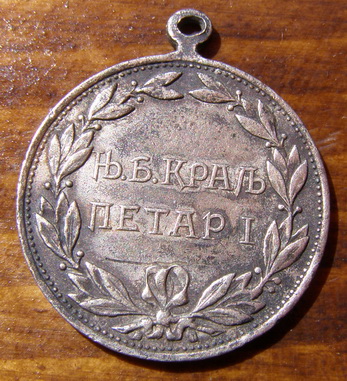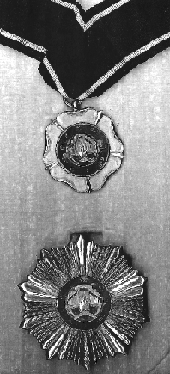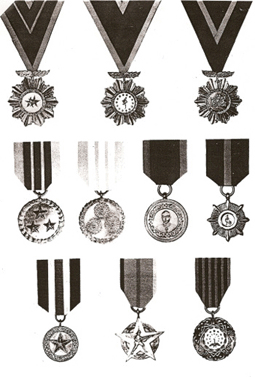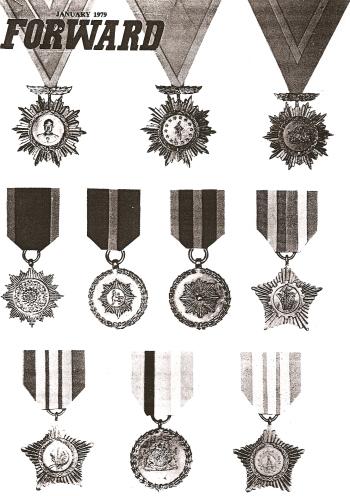
Dragomir
-
Posts
169 -
Joined
-
Last visited
Content Type
Profiles
Forums
Blogs
Gallery
Events
Store
Posts posted by Dragomir
-
-
Antonio,
EN ENORMOUS THANK YOU!!!
Dragomir
0 -
Yes for research on te Bulletin:
And other medals and decorations:
Titre: Dahir n° 1-75-034 du 21 chaaba...
Signataire: Sa Majesté Hassan II... Date de promulgation: 30/ 8/1975
Sujet: Création de médailles commémoratives à l'occasion de la guerre du 10 ramadan 1393.
Titre: Dahir n° 1-79-188 du 18 hija 1...
Signataire: Sa Majesté Hassan II Date de promulgation: 9/11/1979
Sujet: Création de la médaille commémorative de la campagne du Zaïre. .
Titre: Dahir n° 1-81-341 du 3 rebia I...
Signataire: Sa Majesté Hassan II Date de promulgation: 18/ 1/1983
Sujet: Création d'une médaille commémorative dite de l'Opération El Kadr .
Titre: Décret royal n° 199-66 du 1er ...
Signataire: Sa Majesté Hassan II... Date de promulgation: 14/12/1966
Sujet: Création des ordres du Royaume .
Titre: Dahir n° 1-75-033 du 12 rebia ...
Signataire: Sa Majesté Hassan II Date de promulgation: 12/ 4/1976
Sujet: Création d'ordres particuliers à la défense nationale .
Another unsuccessfull attempt to link. Can you be more specific regarding the path?
Regards,
Dragomir
0 -
Hello Antonio,
My attempt to use the link you submitted gave the following response> La page ou le document demandé n’existe pas ou n’est pas encore disponible sur le site.
Is there some other way?
Regards,
Dragomir
0 -
You're welcome.
Thank you both for pointing out the sash detail. So it could be that Order of the Sun of Peru was indeed presented to King Ferdinand, while the sash belongs in fact to an order presented to Queen Maria (the Czechoslovak Order of the White Lion or the Serbian Order of the White Eagle?).
In fact, only White Lion counts as a possibility, White Eagle having light blue stripes, not white.
Dragomir
0 -
All that I have on Moldova ODM:
<a href="http://rapidshare.de/files/40532192/Moldova_ODM.pdf.html" target="_blank">http://rapidshare.de/files/40532192/Moldova_ODM.pdf.html</a>
PDF file, ~8,5 Mb.
I must have missed this link before. Is it still available somewhere, because given link claims that the item is deleted.
Dragomir
0 -
Order of the Sun of Peru
<img src="http://img8.imageshack.us/img8/9518/85401675.jpg" border="0" class="linked-image" />
Attributed to King Ferdinand. Judging by the width of the sash, it might have been conferred to Queen Maria.
This sash does not belong to the Order of the Sun of Peru.
Dragomir
0 -
Emmanuel,
Thank you for postings these great images.
I cannot see the colour of the wreath of leaves around the Grand Councellor badge and star. Is it red?
Cheers,
James
Hello James,
Yes, it is red, only it is not leaves, they are lourie bird feathers.
Dragomir
0 -
Regarding meaning of Orthodox church dignities, let me try to explain a bit:
Bishops Episcops)are high clergy with Apostolic ancestry of office. Between themselves they are organized withing chierarchical ranks, depending on the extent of authority, but they ARE ALL BISHOPS.
From the lowest to the highest rank they are>
VICAR BISHOPS
(ORDINARY) DIOCESAN BISHOPS
ARCHIBISHOPS
METROPOLITANS
PATRIARCHS
In Greek system, which Orthodox churches in Greece and Balkan countries follow, the ranking is slightly different, because ARCHBISHOPS take precedence over METROPOLITANS.
Dragomir
0 -
Here's my take:-
* Орден святого апостола Андрея Первозванного - Order of St. Andrew the First-Called
* Орден святого равноапостольного великого князя Владимира - Order of St. Vladimir
* Орден святой равноапостольной великой княгини Ольги - Order of St Olga
* Орден святителя Иннокентия, митрополита Московского и Коломенского - Order of St. Innocent, Metropolitan of Moscow and Kolomna
* Орден преподобного Сергия Радонежского - Order of St. Sergius of Radonezh
* Орден святого благоверного князя Даниила Московского - Order of St. Daniel of Moscow
* Орден святого мученика Трифона - Order of the Holy Martyr Trifon
* Орден благоверного царевича Димитрия, Угличского и Московского - Order of the Tsarevich Dimitri (Tsarevich is more than mere 'Prince,' more Heir to the Throne)
* Медаль святителя Иннокентия, митрополита Московского и Коломенского - Medal of St. Innocent, Metropolitan of Moscow and Kolomna
* Медаль преподобного Сергия Радонежского - Medal of St. Sergius of Radonezh
* Медаль святого благоверного князя Даниила Московского - Medal of St. Daniel of Moscow
These are very interesting, Roman. Any chance you'd grant permission to add those pictures to my website?
Megan,
May I add some slight corrections to the translation, to make it more compatible with Russian original!
Орден святого апостола Андрея Первозванного - Order of St. Apostle Andrew the First-Called
* Орден святого равноапостольного великого князя Владимира - Order of St. Isoapostle (Meaning "Equal to Apostles")Grand Duke Vladimir
* Орден святой равноапостольной великой княгини Ольги - Order of St. Isoapostle Grand Duchess Olga
* Орден святителя Иннокентия, митрополита Московского и Коломенского - Order of St. Innocent, Metropolitan of Moscow and Kolomna
* Орден преподобного Сергия Радонежского - Order of the Reverend St. Sergius of Radonezh
* Орден святого благоверного князя Даниила Московского - Order of St. Orthodox (Meaning "The one whose faith is just")Prince Daniel of Moscow
* Орден святого мученика Трифона - Order of the Holy Martyr Trifon
* Орден благоверного царевича Димитрия, Угличского и Московского - Order of the Orthodox Tsarevich Dimitri of Uglich and Moscow
* Медаль святителя Иннокентия, митрополита Московского и Коломенского - Medal of St. Innocent, Metropolitan of Moscow and Kolomna
* Медаль преподобного Сергия Радонежского - Medal of The Reverend St. Sergius of Radonezh
* Медаль святого благоверного князя Даниила Московского - Medal of St. Orthodox Prince Daniel of Moscow
Dragomir
0 -
Absolutely, Gordon. In the end, it's always the ordinary people, the people just trying to live as best they can, who are hit the hardest of all. The tears of a Serb mother for her conscript son killed in action in a war, essentially, against his own people are no less valid than those of Behdri Maxun, one of dozens from whom I took statements on my way up through Northern Albania to the border. This is his story:
His wife, daughter and daughter-in-law were in visible need of urgent medical attention as the paramilitaries had taken the balance they considered their due from these women 'in kind', so to speak. However, rape being a taboo subject in such societies, they remained in a huddle under a plastic tarpaulin on the back of the flatbed truck, unwilling to allow strangers to witness their shame, with the menfolk twirling rags in an attempt to keep the flies away.
This was common daily fare there but, in the end, no more cruel than the experience of pulling bits of family members and friends from a Belgrade building hit by a 'smart bomb' or missile. Perhaps the medieval savagery of the killers on the ground was more honest, in a way, than the clinical savagery of clean-shaven young NATO airmen pressing buttons at 35,000 feet. Many of the paramilitaries were Russian veterans of Afghanistan and Chechnya and a lot them were high on cheap heroin and alcohol. I met a few of them as well on my travels and they were scary people.
Others were the inevitable lowlife recruited from prisons and gutters by Arkan's officers and NCOs. A few were nationalists and neo-fascist extremists who had bought into the notion that they were defending the edge of Christendom from encroaching Islam, many Kosovars and Albanians being Muslims. However, these people were Catholics in the main before the Ottoman Turks 'persuaded' them to convert to Islam. I don't know if the people who put the Behdri family out of their houses or the savages who held them up ever answered for it but I do know that I and some of my colleagues handed copies of our notes and photos to the Red Cross and other NGOs, and to the war crimes investigators, and that some families were reunited and some perpetrators arrested.
The whole Balkan experience was a deeply troubling lesson in how thin our veneer of civilisation really is and how ordinary and even pleasant most of the worst killers turned out to be, crazed junkies and drunks apart. Just as ordinary and pleasant, in fact, as the young airmen who bombed Belgrade and other Serb targets, but perhaps more honest, as I said, about the violence to which they were subjecting fellow human beings. As a society, we Westerners tend to recoil from violence if forced to see it up close and acknowledge it.
We'll cheer in pubs when we hear that some mad mullah has been taken out in his slum lair by a missile or a 'smart bomb', without having a care for all the people around his lair who were killed and maimed too. We'll buy the pilot a pint if we meet him. But we will recoil in horror from, say, an IRA man who blew his target up with a car bomb or a Balkan killer who tied a family together with military telephone cable, doused them in petrol and used them as kindling to burn down the farmhouse, even though their actions are not really so different to those of the airman bombing and burning people to death from a great height.
War is sometimes a necessary evil but those who call for it tend to be those who have never seen it close up or are never likely to be directly involved in it. It is a very serious matter and all too often entrusted to politicians who unleash it without taking any personal responsibility for the consequences and who gull the sheeple with all this nonsense about smart bombs, clinical strikes and all the rest of the phraseology aimed at masking the horrific reality while the usual suspects rake in their profits.
PK
I find this kind of posting insulting and unacceptable. Will the Moderator, please, spare us from the rubbish of this kind on the future.
Dragomir
0 -
Hallo Dragomir,

many thanks for the information, were unofficial commemorative pieces common?
Kevin in Deva.

Hallo Kevin,
Unofficial commemorative medals were not rare in Serbia. The portrait posted by Sasa was painted after the death of King Peter I by Uros Predic, and it shows full splendor of the Serbian general's uniform with all the heavy insignia pertaining to the King. In 1903, following the election of Prince Peter Karageorgevich to the throne of Serbia, there was only one specimen of the Chain of Saint Prince Lazarus. Although it was provided by the Law that both King and his Heir, when of age, shall bear the insignia, King Alexander was childless and the second (Crown Prince's) chain was not yet made. The Order of the Star of Karageorge was instituted on January 1st 1904 (Julian Calender, corresponding to the 13th January Gregorian Calender). It seams barely possible that a medal in honour of the King, even if unofficial, would not show the sash of the Star of Karageorge. The habit of wearing the 3rd Class badge at the neck when other sash was used came much later. That is the reason for my attempt at dating.
Best regards,
Dragomir
0 -
Well, Paul Wood might be right in his guess that the medal was probably emitted in 1903. The King is shown only with Collar of St. Prince Lazarus, which means that the portrait originated before the institution of the Order of Star of Karageorge. The spelling error suggests that the Medal was struck abroad, with scant knowledge of the Cyrillic alphabet. Therefore, the guess is that it was struck somewhere abroad, between July and December 1903. Its status was unofficial.
Dragomir
0 -

Can anybody translate the rear?
Kevin in Deva.

Yes. It says: H.M. King Peter I. There is a mistake in capital letter standing for "Majesty" (Cyrillic B in stead of V).
Dragomir
0 -
It's a 32-centimetre long ivory baton with gold, diamond and enamel ornaments. I'll look if I have some better photos.
I could try to scale down the images. Contact me privately.
Hello Carol I,
The photographs are HR, one is 29,2 MB, the other 29,8 MG.
I can reduce them to about 1/3 without damaging the quality, but after that...
Best regards,
0 -
Sometime in the 1970s-80s, Frank Dennis wrote a series of articles about marshal rank officers published in OMSA's "Medal Collector". I recall for sure that one discussed Polish field marshals, am fairly sure some described French marshals, and he may have written on Romanian and Russian marshals. At least the Polish article illustrated a marshal's baton. Unfortunately, I do not have access to those journals or the various "Medal Collector" indexes--perhaps someone else can find the exact cites for Dennis' work?
EJ is, as usual, quite right!
I coauthored some of these articles with late General Dennis, particularly those dealing with orders, decorations and medals of the field-marshals of Kingdom of Serbia and the single one of the Kingdom of Yugoslavia (Franchet d'Esperey). In fact, Serbian and Yugoslavian field-marshals never possessed an insignia in the form of baton. That is why I find the attribution of the mysterious baton from the Romanian museum rather amazing. It would be nice if somebody could provide more detailed photographs of the artefact. I have excellent photos of the Romanian baton presented by King of Romania to King Alexander of Yugoslavia, but - as always - I have problem with scaling down to the required limit. Therefore, anyone that can do the scaling down for me is welcome.
By the way, field-marshal's baton is a hollow container protecting written appointment and warrant giving the authority and command to a chief commanding officer in the field.
Dragomir
0 -
Gentlemen,
This a late call to the theme of Hawaiian medals, but I just found a partial photostat copy of a Catalogue of an exhibition dedicated to Kamehameha, and there are some clues as to the issue of Hawaiian medals. Since front pages are missing, I can contribute only the incomplete information, but I am sure that in some good public library the full copy of the Catalogue can be traced.
Here is the :
- King David Kalakaua election medal 1874 (diamond shape)--red, white, blue ribbon: No. 263 in the Catalogue, described as being silver, gold, silk, enamel. Size is 4,6x11,2 cm (obviously together with ribbon, which - I guess - is white-blue-red-blue-white). There is Spanish-looking metal clasp at the top of the ribbon. The lozenge shaped Medal is charged with an engraved Maltese cross defaced with a heart shaped medallion inscribed K. Above the cross is engraved MOI, under 1884, left and right Feb. 12.
- Kalakaua & Kapiolani Medal 1884 for their 10th anniversary (presented & sold): No. 264 in Catalogue. Size is 31mm, silver, surmounted by a Hawaiian Crown and elaborate metal ornament. Obverse displays profile portraits of Kapiolani and Kalakaua surrounded by a circumscription KALAKAUA - KAPIOLANI - FEB.12.1884. . I can not recognize ribbon colours.
- King Kalakaua Jubilee medal 1886 blue ribbon (presented & sold): No. 265 in Catalogue. Size is 39mm, silver, surmounted by a Hawaiian Crown and elaborate metal ornament. Obverse displays contourned profile of Kalakaua, surrounded with circumscrpiton KALAKAUA MOI O HAWAII 1886. I can not recognize the ribbon colours.
- Coat of Arms Medal: No. 266 in the Catalogue. Size is 55 mm, gold and brass, in shape of a sanded Maltese cross with polished edges. Central medallion is circular and charged in obverse with Hawaaian Greater Coat of Arms. No ribbon known.
- Hail Kalakaua Medal: No. 267 in the Catalogue. Size is 35x50mm, gold, in shape of a baroque targe, with engrabved Royal Crown of Hawaii in center of obverse surrounded with text KALAKAUA 1883 REX HAWAII engraved above and under the Crown, and in reverse AVE KALAKAUA 1893 POLUNESIAE. No ribbon known.
- World Tour Medal: No. 268 in the Catalogue. Maltese cross made of stainless steel, with central medallion made as revolving terrestrial globe of ceramics with marking of the around-the-world Royal Tour 1881. The cross is surmounted with a steel ribband knotted and engraved 1874-1881. The ribbon is (my guess!) blue, edged white along the dexter (heraldic) side, and blue at the sinister.
Dragomir
0 -
This is very exciting. The 1st class badge I inspected had no enamel on petals, it is pure gold, and regarding the size - it is much smaller than I.E. I shall try to get somehow a better colour picture. The set illustrated b/w was awarded to Konstantin Popovich, once Tito's Foreign Minister.
Emmanuel, you are a treasure trove.
Dragomir
0 -
When I am at that, here is picture of the 1st Class Order of the Union of Burma.
Dragomir
 0
0 -
I have no idea what went amiss!
Dragomir
 0
0 -
Here comes the picture No. 2.
Dragomir
0 -
Thanks to Emmanuel's help, here follows information regarding Myanmar awards.
Here are scans of the front and back pages of the "Forward" Magazine. Alas, I have only b/w copies. The identification comes from the same source, claiming that "On 11 July 1978, the Council of State issued a notification (32/78) of provisions regarding titles and decorations.", which runs as folliows:
Myanmar-1:
1st row= Aung San Tagun, Pyidaungsu Tagun, Tagun
2nd row= Aung San Thuriya, Thiha Thura, Thura, Decoration for Performance for Development of Socialist Economy,
3rd row= 1st class Medal for Excellent Performance in Agricultural Field of Economy, 1st class Medal for Excellent Performance in Both Fields of Democracy, 1st class Medal for Excellent Performance in the Industrial Field of Economy.
Myanmar-2:
1st row= Lanzin Zarni, Pyidaungsu Zarni, Zarni
2nd row= 1st class Medal for Excellent Performance in Manegerial Field, 1st Class Medal for Excellent Performance in Social Field, Aung San Medal, Thiha Bala Medal,
3rd row= Medal for being Mentioned in Despatches, A-ye-daw-bon Medal, Medal for Organization for Independence.
There is another text in English, titled "Titles and Decorations" and signed by one Soe Myint, explaining the succus of the system. There are "Titles" and "Decorations". Titles consist of Titles to be conferred for performance and service, being Tagun Group (Aung San Tagun, Pyuidaungsu Tagun and Tagun) and Zarni Group (Lanzin Zarni, Pyiudaungsu Zarni and Zarni), and of Titles to be conferred for valour and courage, being Aung San Thuriya, Thiha Thura and Thura. Decorations are conferred for performance and service, being organized as Decorations for Development of Socialist Economy (Medal for Excellent Performance in Both Fields of Socialist Economy, Medal for Excellent Performance in Agricultural Field of the Economy, with 3 classes, and Medal for Excellent Performance in Industrial Field of the Economy, also with 3 classes) and Decorations for Development of Socialist Democracy (Medal for Excellent Performance in Both Fields of Socialist Democracy, Medal for Excellent Performance in Managerial Field, with 3 classes, and Medal for Excellent Performance in Social Field, also with 3 classes). Next, there are "Tatmandaw" recompenses (actually Myanmar Armed Forces), which consist of decorations of valour and courage: Aung San Medal, Thiha Bala Medal, Medal for being mentioned in Despatches, A-ye-daw-bon Medal, Medal for Organization for Independence, Medal of Liberation, Good Military Service Medal, Medal of Good Son of the People, Medal for Sacrifice, Medal for Military Service to the State, Medal for Victory over Enemy and Medal for Battle in People's War.
Police has own syspet of awards, being:
Decorations for valour and courage: Yethiha, Yethura and Yebala (being three classes of the same award), and
Decorations for Service: Yethurain, Yekyawswa, Yekyawthu (being three classes of the same award), Good Police Service Medal and Medal for Police Service to the State.
I hope this will help to clarify rather murky information regarding awards of Myanmar.
Yours,
Dragomir
 0
0 -
The first of several photos of unknown Burma/Myanmar pieces. The one with 3 stars on the obverse is described as "Peace Medal, Shan Border".
Any information greatly appreciated.
I guess that the medal on the left side might be Alinga Kyaw Swa, which belonged to the category "Swe" (Titles) on the page 11 of the publication "Orders, Titles and Decorations of The Union of Burma". However, the ribbon is decribed as being "safron, with dark brown stripe 2.10 inch wide in the centre".
Dragomir
0 -
I am delighted with all the fantastic information. I wanted to add two illustrations (front and back pages of the Burmese Magazine "Forward" pf January 1979) that might clarify at least some dilemmas. Lamentably, the files, although I have reduced JPEG size to some 400 kb, are still too large to load.
Can someone help?
Dragomir
0 -
Ulsterman,
To put you out of your misery, here is a scan of a Yugo award document. This document does not go with the awards in this thread. It is just to give you an idea of what one would look like. Pretty plain and no place for a number and the award this document came with isn't numbered anyway.
Regards,
Gordon
In fact this is not a proper awarding document. It is rather an official affidavit, confirming that the owner has been awarded the order. Proper awarding document for senior classes was usually more elaborate. However, since some orders were conferred in hundreds of thousands, for lower classes in stead of proper documents this type of affidavits were considered to suffice. If the awardee insisted, he would eventually get a proper document in due time.
Dragomir
0


What medals did Emperor Haile Selassie wear?
in Africa
Posted
Some comments regarding the identification:
First row: I am not aware that "torch" ribbon distinction mark was used in Ethiopia. Is it possibly palm?
Third row: German Order of Merit displays here star with 6 points in stead of 8 for the Special Class,Aztec Eagle is (for me) invisible (perhaps the last unidentified ribbon in the 2nd row is more likely Aztec Eagle?), between Tunisia and Czechoslovakia there is apparently Liberia Pioneers, not Ivory Coast, the unidentified item between Brazil and Holy Sepulchre looks like Korean thing (Taeguk in middle)second "unknown of sequence of three is Orthodox Crusaders of the Holy Sepulchre of the Greek Patriarchate of Jerusalem,;
Fourth row: Lion of Senegal is better choice than Leopard of Somalia, unknown item between Netherlands and Burma should be Order of St. Mark of the Orthodox Patriarchate of Alexandra, and item between Morocco and Venezuela might be Rumanian (Communist)Star Order.
Yours,
Dragomir